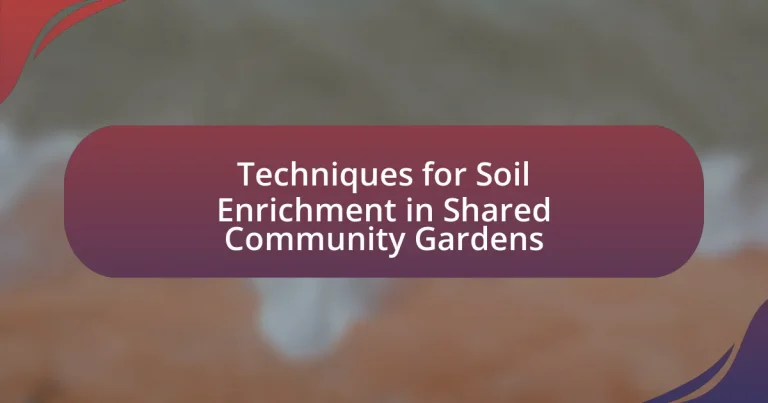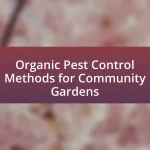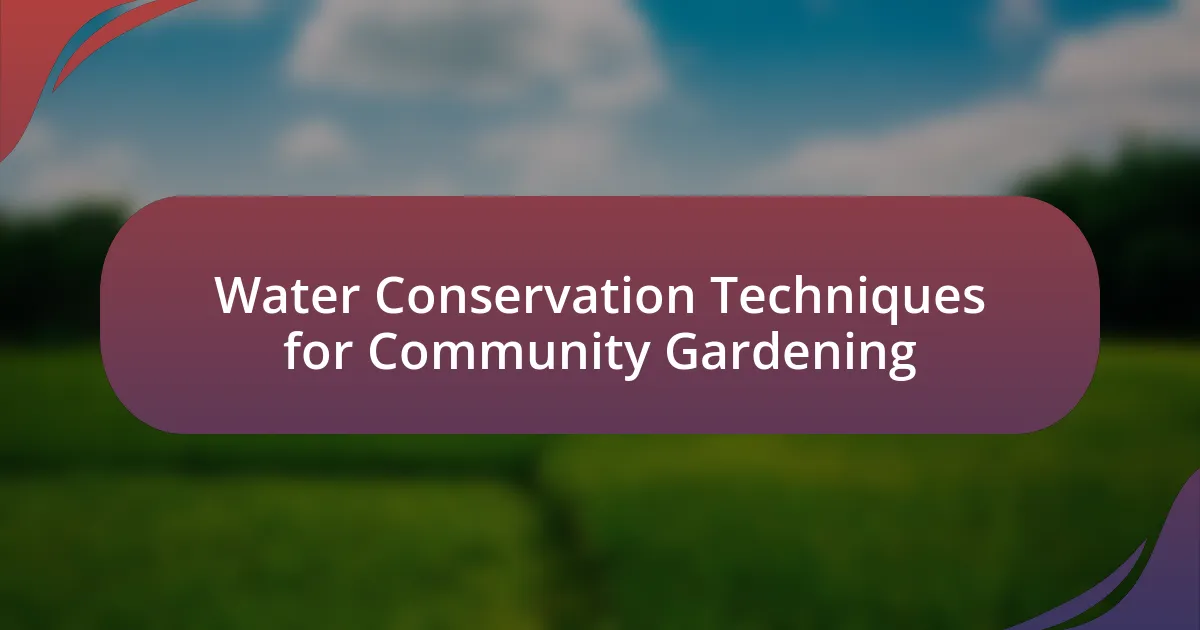The article focuses on techniques for soil enrichment in shared community gardens, highlighting methods such as composting, cover cropping, and the use of organic fertilizers. These techniques improve soil quality by enhancing nutrient availability, increasing organic matter, and promoting beneficial microbial activity, which collectively lead to healthier plants and increased crop yields. The article also addresses the specific soil properties enhanced by these practices, the importance of soil health in sustainable gardening, and the role of community engagement in implementing soil enrichment techniques. Additionally, it discusses common challenges faced by community gardens and offers best practices for maintaining enriched soil.
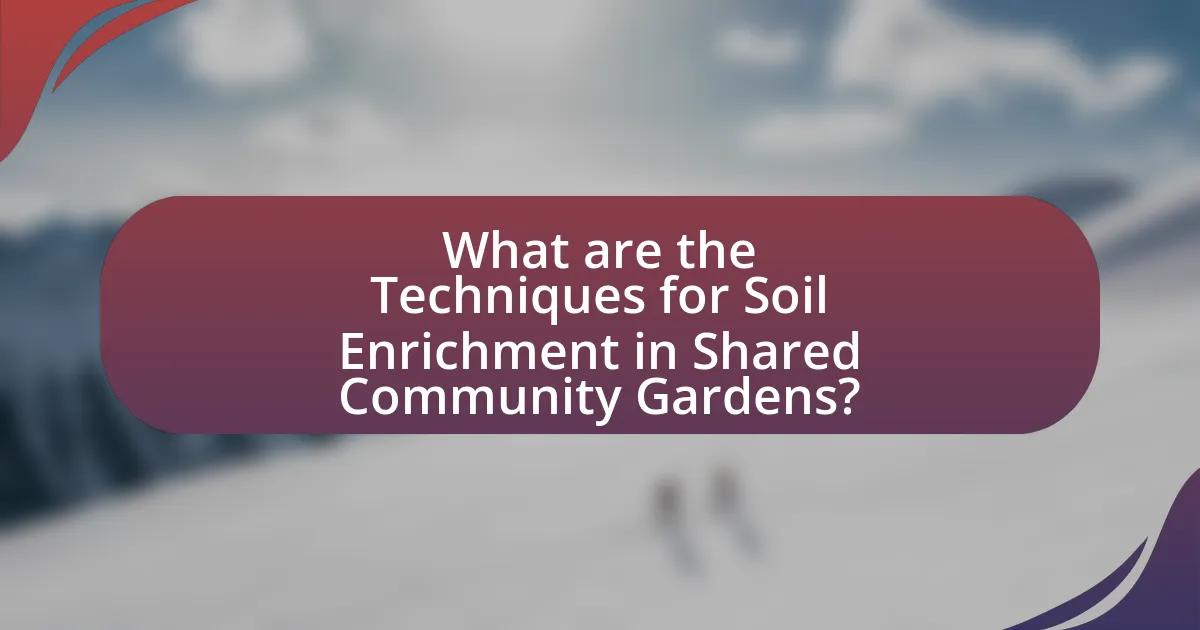
What are the Techniques for Soil Enrichment in Shared Community Gardens?
Techniques for soil enrichment in shared community gardens include composting, cover cropping, and the application of organic fertilizers. Composting involves recycling organic waste to create nutrient-rich soil amendments, which can improve soil structure and fertility. Cover cropping, such as planting legumes, enhances soil nitrogen levels and prevents erosion. Organic fertilizers, like bone meal or fish emulsion, provide essential nutrients without harmful chemicals, promoting a healthier ecosystem. These methods are supported by studies showing that organic practices can significantly increase soil health and productivity in community gardens.
How do these techniques improve soil quality?
Techniques for soil enrichment, such as composting, cover cropping, and crop rotation, improve soil quality by enhancing nutrient availability, increasing organic matter, and promoting soil structure. Composting adds essential nutrients and beneficial microorganisms, which enhance soil fertility and microbial activity. Cover cropping prevents erosion, suppresses weeds, and improves soil structure through root systems that create channels for air and water. Crop rotation disrupts pest and disease cycles while maintaining nutrient balance, as different crops utilize varying soil nutrients. Research indicates that these practices can increase soil organic matter by up to 5% over several years, significantly boosting soil health and productivity.
What specific soil properties are enhanced by these techniques?
The specific soil properties enhanced by techniques for soil enrichment in shared community gardens include increased organic matter content, improved soil structure, enhanced nutrient availability, and better moisture retention. These techniques, such as composting, cover cropping, and mulching, contribute to a higher concentration of beneficial microorganisms, which in turn promotes nutrient cycling and improves soil fertility. For instance, composting can increase organic matter by 30% or more, leading to improved soil aeration and water infiltration, while cover crops can enhance nitrogen levels, benefiting subsequent plant growth.
How do these improvements affect plant growth and yield?
Improvements in soil enrichment techniques significantly enhance plant growth and yield. Enhanced soil quality leads to better nutrient availability, improved water retention, and increased microbial activity, all of which contribute to healthier plants. For instance, studies have shown that organic amendments, such as compost, can increase crop yields by up to 30% compared to conventional practices, as they provide essential nutrients and improve soil structure. Additionally, enriched soils support a diverse microbial community, which aids in nutrient cycling and plant health, further boosting productivity in community gardens.
Why is soil enrichment important in community gardens?
Soil enrichment is important in community gardens because it enhances soil fertility, leading to healthier plants and increased crop yields. Enriched soil contains essential nutrients such as nitrogen, phosphorus, and potassium, which are vital for plant growth. Research indicates that community gardens with enriched soil can produce up to 30% more vegetables compared to those with depleted soil. Additionally, enriched soil improves soil structure and water retention, which supports sustainable gardening practices and promotes biodiversity within the garden ecosystem.
What role does healthy soil play in sustainable gardening?
Healthy soil is essential for sustainable gardening as it supports plant growth, enhances biodiversity, and improves water retention. Healthy soil contains a rich community of microorganisms, organic matter, and nutrients that facilitate the growth of plants, which in turn contributes to a balanced ecosystem. Research indicates that soil health directly correlates with crop yield and resilience; for instance, a study published in the journal “Agriculture, Ecosystems & Environment” found that soils with higher organic matter content can increase crop productivity by up to 30%. Additionally, healthy soil reduces the need for chemical fertilizers and pesticides, promoting an environmentally friendly approach to gardening.
How does soil enrichment contribute to community engagement and education?
Soil enrichment fosters community engagement and education by providing hands-on learning opportunities and promoting collaboration among community members. Engaging in soil enrichment activities, such as composting and organic amendments, allows individuals to learn about sustainable practices and the importance of healthy soil for plant growth. Research indicates that community gardens enhance social interaction and knowledge sharing, as participants often exchange techniques and experiences related to soil management. For instance, a study published in the Journal of Community Gardening found that participants reported increased awareness of environmental issues and improved gardening skills through collaborative soil enrichment efforts. This collective involvement not only strengthens community bonds but also cultivates a deeper understanding of ecological principles among participants.

What are the Common Techniques for Soil Enrichment?
Common techniques for soil enrichment include the application of organic matter, crop rotation, cover cropping, and the use of compost. Organic matter, such as manure or leaf litter, improves soil structure and nutrient content. Crop rotation helps prevent nutrient depletion and reduces pest and disease cycles. Cover cropping, where plants are grown during off-seasons, enhances soil fertility and prevents erosion. Composting recycles organic waste into nutrient-rich soil amendments, promoting microbial activity and improving soil health. These methods are widely recognized for their effectiveness in enhancing soil quality in community gardens.
How does composting contribute to soil enrichment?
Composting contributes to soil enrichment by enhancing soil structure, increasing nutrient content, and promoting microbial activity. The organic matter in compost improves soil aeration and water retention, which are essential for healthy plant growth. Additionally, compost adds essential nutrients such as nitrogen, phosphorus, and potassium, which are vital for plant development. Research indicates that compost can increase soil organic matter by 5-10%, significantly improving soil fertility and productivity. Furthermore, composting fosters a diverse microbial community that aids in nutrient cycling and disease suppression, further enriching the soil ecosystem.
What materials are best for composting in community gardens?
The best materials for composting in community gardens include a balanced mix of green materials, such as vegetable scraps, grass clippings, and coffee grounds, along with brown materials like dried leaves, straw, and cardboard. This combination is essential because green materials provide nitrogen, while brown materials supply carbon, creating an optimal environment for microbial activity that accelerates decomposition. Research indicates that maintaining a carbon-to-nitrogen ratio of about 30:1 enhances composting efficiency, leading to nutrient-rich compost that benefits soil health in community gardens.
How can composting be effectively implemented in shared spaces?
Composting can be effectively implemented in shared spaces by establishing designated compost bins that are easily accessible to all community members. These bins should be clearly labeled and located in a central area to encourage participation. Education on what materials can be composted, such as fruit and vegetable scraps, coffee grounds, and yard waste, is essential to ensure proper usage. Regular maintenance, including turning the compost and monitoring moisture levels, should be assigned to volunteers or a community gardening committee to keep the compost healthy and active. Research indicates that community composting initiatives can reduce waste by up to 30%, fostering a sense of community and environmental responsibility among participants.
What is the role of cover crops in soil enrichment?
Cover crops play a crucial role in soil enrichment by improving soil structure, enhancing nutrient availability, and preventing erosion. These crops, such as clover and rye, contribute organic matter to the soil, which increases microbial activity and nutrient cycling. Research indicates that cover crops can increase soil organic carbon levels by 0.5 to 1.0 tons per acre annually, thereby enhancing soil fertility and health. Additionally, they help fix nitrogen in the soil, reducing the need for synthetic fertilizers and promoting sustainable gardening practices.
Which cover crops are most beneficial for community gardens?
Leguminous cover crops, such as clover and vetch, are most beneficial for community gardens due to their ability to fix nitrogen in the soil, enhancing soil fertility. These crops contribute organic matter, improve soil structure, and suppress weeds. Research indicates that clover can increase soil nitrogen levels by up to 150 pounds per acre, while vetch can provide similar benefits, making them ideal choices for enriching soil in community gardens.
How do cover crops improve soil structure and fertility?
Cover crops improve soil structure and fertility by enhancing soil aggregation and increasing nutrient availability. The roots of cover crops create channels in the soil, which improves aeration and water infiltration, leading to better root development for subsequent crops. Additionally, cover crops contribute organic matter to the soil when they decompose, which increases the soil’s nutrient content and microbial activity. Research indicates that using cover crops can increase soil organic matter by 0.5 to 1.0% per year, significantly boosting soil fertility over time.
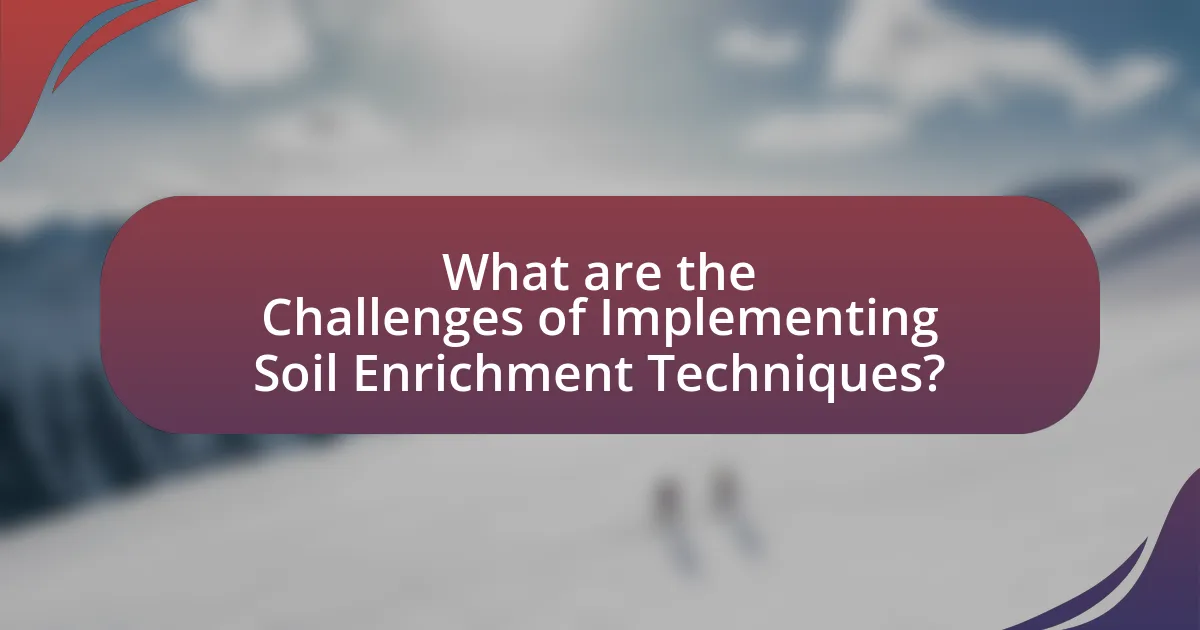
What are the Challenges of Implementing Soil Enrichment Techniques?
The challenges of implementing soil enrichment techniques include cost, knowledge gaps, and environmental impact. Cost can be a significant barrier, as purchasing organic materials or amendments may strain community budgets. Knowledge gaps among community members can hinder effective application, as improper techniques can lead to poor results or even soil degradation. Environmental impact concerns arise when synthetic fertilizers are used, potentially leading to water pollution and harming local ecosystems. These challenges necessitate careful planning and education to ensure successful soil enrichment in shared community gardens.
What common obstacles do community gardens face in soil enrichment?
Community gardens commonly face obstacles in soil enrichment due to contamination, nutrient depletion, and limited access to resources. Contamination often arises from previous land use, where heavy metals or chemicals can hinder soil health. Nutrient depletion occurs as plants extract essential minerals over time without adequate replenishment. Additionally, limited access to quality compost or organic materials restricts the ability of gardeners to enhance soil fertility effectively. These challenges can significantly impact the productivity and sustainability of community gardens.
How can these challenges be overcome through collaboration?
Collaboration can overcome challenges in soil enrichment for shared community gardens by pooling resources, knowledge, and labor among community members. When individuals work together, they can share best practices for soil management, such as composting techniques and crop rotation strategies, which have been shown to enhance soil fertility and structure. For instance, a study by the American Community Gardening Association found that community gardens that utilized collaborative composting efforts increased soil organic matter by 30% over a single season. This collective approach not only improves soil quality but also fosters a sense of community ownership and responsibility, leading to more sustainable gardening practices.
What resources are available to assist community gardens in soil enrichment?
Community gardens can access various resources for soil enrichment, including local agricultural extension services, composting programs, and soil testing laboratories. Agricultural extension services provide expert advice on soil health and enrichment techniques tailored to specific regional conditions. Composting programs offer organic materials that enhance soil fertility, while soil testing laboratories analyze nutrient levels and pH, guiding gardeners on necessary amendments. These resources collectively support community gardens in improving soil quality and productivity.
How can community members be educated about soil enrichment techniques?
Community members can be educated about soil enrichment techniques through workshops, hands-on demonstrations, and informational resources. Workshops can be organized by local agricultural extension services or community organizations, providing practical knowledge on composting, cover cropping, and organic amendments. Hands-on demonstrations allow participants to engage directly with soil enrichment practices, reinforcing learning through experience. Additionally, distributing informational resources such as pamphlets or online guides can provide ongoing support and reference materials. Research indicates that community engagement in educational programs significantly enhances knowledge retention and application, as seen in studies conducted by the University of California Cooperative Extension, which found that participants in hands-on workshops improved their soil management skills by over 60%.
What workshops or programs can be organized to promote soil health?
Workshops and programs that can be organized to promote soil health include hands-on soil testing workshops, composting seminars, and cover cropping demonstrations. Soil testing workshops educate participants on assessing soil quality and nutrient levels, which is essential for informed gardening practices. Composting seminars teach the benefits of organic matter in enhancing soil structure and fertility, supported by research indicating that compost can improve soil microbial activity and nutrient availability. Cover cropping demonstrations illustrate how planting specific crops can prevent erosion, suppress weeds, and enhance soil organic matter, with studies showing that cover crops can increase soil health indicators significantly.
How can sharing success stories enhance community involvement?
Sharing success stories enhances community involvement by creating a sense of belonging and motivation among community members. When individuals hear about successful initiatives, such as effective soil enrichment techniques in shared community gardens, they are more likely to engage and participate in similar projects. Research indicates that storytelling fosters social connections and encourages collective action, as evidenced by a study published in the Journal of Community Psychology, which found that communities with shared narratives experienced increased participation rates in local initiatives. This demonstrates that sharing success stories not only informs but also inspires community members to contribute actively to their shared environment.
What are the best practices for maintaining enriched soil in community gardens?
The best practices for maintaining enriched soil in community gardens include regular addition of organic matter, crop rotation, and soil testing. Regularly incorporating compost or well-rotted manure enhances soil fertility and structure, providing essential nutrients for plant growth. Crop rotation prevents nutrient depletion and reduces pest and disease buildup, promoting a balanced ecosystem. Soil testing, conducted every few years, identifies nutrient deficiencies and pH levels, allowing for targeted amendments. These practices collectively ensure that the soil remains healthy and productive, supporting sustainable gardening efforts.
